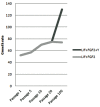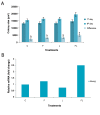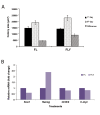Optimization of Buffalo (Bubalus bubalis) Embryonic Stem Cell Culture System
- PMID: 26199905
- PMCID: PMC4503840
- DOI: 10.22074/cellj.2016.3728
Optimization of Buffalo (Bubalus bubalis) Embryonic Stem Cell Culture System
Abstract
Objective: In order to retain an undifferentiated pluripotent state, embryonic stem (ES) cells have to be cultured on feeder cell layers. However, use of feeder layers limits stem cell research, since experimental data may result from a combined ES cell and feeder cell response to various stimuli.
Materials and methods: In this experimental study, a buffalo ES cell line was established from in vitro derived blastocysts and characterized by the Alkaline phosphatase (AP) and immunoflourescence staining of various pluripotency markers. We examined the effect of various factors like fibroblast growth factor 2 (FGF-2), leukemia inhibitory factor (LIF) and Y-27632 to support the growth and maintenance of bubaline ES cells on gelatin coated dishes, in order to establish feeder free culture systems. We also analyzed the effect of feeder-conditioned media on stem cell growth in gelatin based cultures both in the presence as well as in the absence of the growth factors.
Results: The results showed that Y-27632, in the presence of FGF-2 and LIF, resulted in higher colony growth and increased expression of Nanog gene. Feeder-Conditioned Medium resulted in a significant increase in growth of buffalo ES cells on gelatin coated plates, however, feeder layer based cultures produced better results than gelatin based cultures. Feeder layers from buffalo fetal fibroblast cells can support buffalo ES cells for more than two years.
Conclusion: We developed a feeder free culture system that can maintain buffalo ES cells in the short term, as well as feeder layer based culture that can support the long term maintenance of buffalo ES cells.
Keywords: Buffalo; Embryonic Stem Cells; FGF-2; LIF; Y-27632.
Figures






Similar articles
-
Developmental Competence of Buffalo (Bubalus bubalis) Pluripotent Embryonic Stem Cells Over Different Homologous Feeder Layers and the Comparative Evaluation with Various Extracellular Matrices.Int J Stem Cells. 2013 May;6(1):26-36. doi: 10.15283/ijsc.2013.6.1.26. Int J Stem Cells. 2013. PMID: 24298371 Free PMC article.
-
Activation and Inhibition of The Wnt3A Signaling Pathway in Buffalo (Bubalus bubalis) Embryonic Stem Cells: Effects of WNT3A, Bio and Dkk1.Int J Fertil Steril. 2015 Oct-Dec;9(3):361-70. doi: 10.22074/ijfs.2015.4552. Epub 2015 Oct 31. Int J Fertil Steril. 2015. PMID: 26644860 Free PMC article.
-
Optimization of culture conditions to support long-term self-renewal of buffalo (Bubalus bubalis) embryonic stem cell-like cells.Cell Reprogram. 2011 Dec;13(6):539-49. doi: 10.1089/cell.2011.0041. Epub 2011 Oct 26. Cell Reprogram. 2011. PMID: 22029416
-
Generation and characterization of embryonic stem-like cell lines derived from in vitro fertilization Buffalo (Bubalus bubalis) embryos.Reprod Domest Anim. 2010 Feb;45(1):122-8. doi: 10.1111/j.1439-0531.2008.01268.x. Epub 2008 Dec 22. Reprod Domest Anim. 2010. PMID: 19144015
-
Engineering biomaterials for feeder-free maintenance of human pluripotent stem cells.Int J Stem Cells. 2012 May;5(1):1-5. doi: 10.15283/ijsc.2012.5.1.1. Int J Stem Cells. 2012. PMID: 24298348 Free PMC article. Review.
References
-
- Zandi M, Muzaffar M, Shah SM, Kaushik R, Singh MK, Palta P, et al. WNT3A signalling pathway in buffalo (Bubalus bubalis) embryonic stem cells. Reprod Fertil Dev. 2014;26(4):551–561. - PubMed
-
- Sharma R, Kamble NM, George A, Chauhan MS, Singla S, Manik RS, et al. Effect of TGF-β1 superfamily members on survival of buffalo (Bubalus bubalis) embryonic stem-like cells. Reprod Domest Anim. 2013;48(4):569–576. - PubMed
-
- Valdimarsdottir G, Mummery C. Functions of the TGFbeta superfamily in human embryonic stem cells. APMIS. 2005;113(11-12):773–89. - PubMed
-
- Mannello F, Tonti GA. Concise review: no breakthroughs for human mesenchymal and embryonic stem cell culture: conditioned medium, feeder layer, or feeder-free; medium with fetal calf serum, human serum, or enriched plasma; serum-free, serum replacement nonconditioned medium, or ad hoc formula?. All that glitters is not gold! Stem Cells. 2007;25(7):1603–1609. - PubMed
LinkOut - more resources
Full Text Sources
Research Materials
